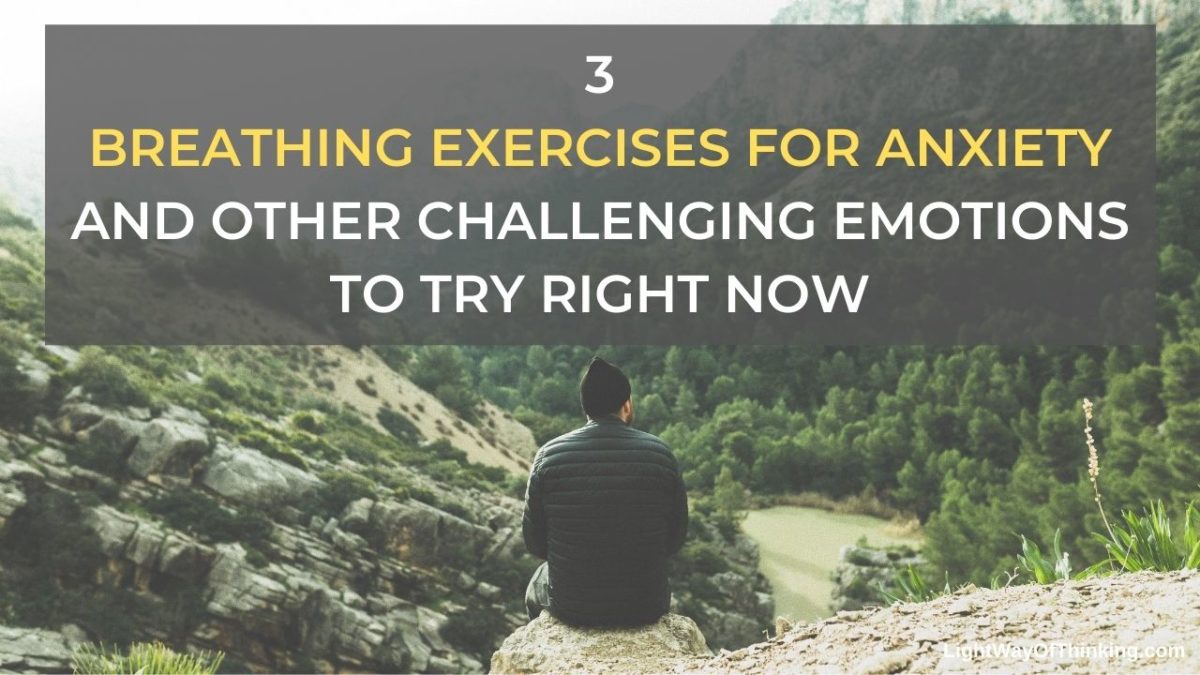As a man, I think you and I can both agree that we come up across many challenging situations in life. It’s in these situations where using breathing exercises for anxiety or other difficult emotions can really help.
Maybe your boss is being annoying, your family is pissing you off, you got injured, something didn’t go your way…there are so many things that can cause stress and aggravation.
To calm down, most things you read online recommend “deep breathing”, “taking some deep breaths”, or something like the “4 7 8 breath”.
Sometimes this all works, true. I don’t know about you though, but a lot of times that pisses me off because if I don’t start calming down within a few seconds, I start feeling WORSE.
In this article, I’ll go over 3 breathing exercises for anxiety and other challenging emotions you can use to help yourself through them. They are all simple, easy to learn, and start helping you within minutes.
1. The Simple Deep Breathing Exercise
This is the most common exercise that’s recommended to deal with challenging or even repressed emotions. The main idea is that when you are under any sort of stress, your breathing becomes harsh, shallow, or you might not be breathing well at all.
With this exercise, the goal is to purposely focus on slowing down your breathing, so that you activate the body-mind connection where your breath is telling your body (and brain) that, “Everything is OK. You can relax.”
Instructions
- Sit or lie down in a comfortable place and position, where you won’t be disturbed and are safe
- You may choose to put one hand over your heart/chest, and the other on your stomach
- Close your eyes
- Breathe in for 3-5 seconds through your nose, and focus on expanding your belly/stomach (practice diaphragmatic breathing)
- Hold your breath for 3-5 seconds
- Breathe out through your mouth for a count that is longer than your breath in (e.g. if you breathed in for 5 seconds, breath out for at least 6), focusing on expelling all of the air in your belly and lungs
- Wait 3-5 seconds
- Repeat steps 4 through 7 for at least one minute
To help, some people take breaths in sync with this image.
What I like about this technique is that it’s very simple and can work well. In moderate cases of challenging emotions and anxiety, I find it calms me down.
HOWEVER:
I sometimes find it makes things worse. The reason being that you are trying to force your breath to slow down and control an emotion. As I’ll keep repeating throughout this article, trying to control a situation or your emotions usually just everything worse (what you resist persists). I find that if this technique doesn’t start working for me fairly quick, I might start feeling more anxious, or get pissed off that it’s not working.
That’s why I usually recommend these other two options.
2. Breathing into the Pain
The second option is to use the breath to acknowledge and feel the emotion, instead of trying to change it with your breathing pattern. In this sense, it might even make a bit stronger. But, in my opinion, it’s far better than trying to change things.
But of course, this is easier said than done. Feeling challenging emotions is not easy.
This technique comes from hypnotherapy, and uses visualization to help work with the challenging emotions.
Instructions
- Sit or lie down in a comfortable place and position, where you won’t be disturbed and are safe
- Close your eyes
- Try to feel where the challenging emotion is being triggered the most in your body. Common trouble spots include your:
- Throat
- Chest
- Forehead
- Eyes
- Stomach
- Jaw
- Visualize breathing light into this area, taking light from above/the sky as a beam into the center / area of difficulty while you breathe in through your nose
- Wait 3-5 seconds
- Breathe out darkness through your mouth and see the darkness leaving the area
- Ensure that your out-breath is longer than your in-breath as per exercise #1
- Repeat steps 3 through 7 for at least one minute, or as much as you need to feel the emotion calming down
Again, this focuses on accepting the emotion as it is, feeling it. I find this technique works very well, especially when used alongside the third and final technique.

3. Acceptance Breathing (Anapana and Vipassana Meditation)
One of the most transformational techniques I have found is based on the benefits I’ve seen from Vipassana meditation and retreats.
Vipassana teaches one to accept reality exactly as it is, not as you would like it to be. It also teaches the basic law of nature, that everything is impermanent. Good things come and go, as do “bad” things.
Based on this, you learn to not try to change things or resist them. You just accept them as they are, knowing that they’ll eventually pass.
Now:
LET me tell YOU that this sounds all nice and Buddhist like, but fuck is it difficult to practice.
I can even hear you saying it now: “But Noam, I don’t want this feeling. It sucks.”
Trust me man, I KNOW.
It’s not easy, and it takes practice, but this is the most powerful way to deal with challenging emotions and learning how to love yourself (this is all part of self-care and acceptance).
We specifically focus on Anapana meditation, or breathing meditation, where instead of trying to force a breathing rhythm, or visualize something happening. we simply accept our breath exactly as it is: Deep or shallow, fast or slow, harsh or soft, and eventually, find that the breathing will change.
Your breathing is intimately tied to your emotional state, so as your breathing calms down, so too will your emotions.
Instructions
- Sit or lie down in a comfortable place and position, where you won’t be disturbed and are safe
- You might want to set a timer to go off after a certain amount of time (1-10 minutes)
- Close your eyes
- Focus your attention around your nose and the breath going in and out of your nostrils. Feel any sensations around there. These might be: the difference in temperature of the in-breath and out-breath, noticing the speed at which you are breathing. Anything!
- Keep focusing on this area and your breath until the timer goes off
While you can’t force yourself to calm down or something to change, you can accept as it is and naturally, over time, you will return to a baseline state.
Nothing lasts forever.
Use These Breathing Exercises for Anxiety and Other Challenging Emotions
Anxiety, anger, frustration, sadness…all these “low” or “negative” emotions are a part of being human.
We can’t get rid of them. In fact, trying to get rid of them will cause more pain than accepting and listening to them, as they are signals to communicate our emotional needs and what we need in the moment.
That said, they can be challenging at times, and our emotional and physical states are so intertwined, that you will find that the breath must change given a spike in emotions.
By learning to work with the breath, you can use these breathing exercises for anxiety and other challenging emotions to learn to work with them instead of endlessly fighting against them.

